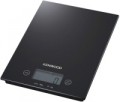Max. measurement weight
The largest weight that is allowed to be placed on the platform of this scale model. If this parameter is exceeded, the scales, at best, will not be able to show the correct data, at worst, they will completely fail. Obviously, the maximum weight is directly related to the purpose, but even kitchen scales can weigh both
up to 5 kg and up to 20 kg.
Actually, floor scales have the largest maximum measurement weight, in such models it can reach
200 kg or even more. And the most delicate are
jewelry models (refer to "Type"). Also note that in mechanical devices (refer to "Mechanism") the scale is usually graduated to the maximum weight.
Now on the market there are scales with such a maximum weight:
up to 1 kg,
up to 5 kg,
up to 10 kg,
up to 50 kg,
up to 150 kg,
up to 200 kg.
Units of measurement
Weights are able to keep records in various units of measurement, while accounting can be done both by mass and by volume. Among the most common units of measurement, we highlight the following.
— Grams (g) — a unit of weight that belongs to the metric system. Grams are used in desktop kitchen scales.
— Kilograms (kg) — a unit of weight that belongs to the metric system. Kilograms are used in floor weighing equipment.
— Pounds (lb:oz) is a common unit of weight used in some countries in Europe, as well as in the United States. 1 pound can be equated to 0.45 kilograms.
— Milliliters (ml) — a unit of volume that belongs to the metric system. Some models of scales are able to determine the volume of milk and water based on mass.
— Ounces (fl'oz) is a unit of volume used in English-speaking countries. 1 US ounce is equivalent to 30 mL.
— Stones (st) is the British unit of weight. Stones are used to take into account the mass of the human body, so this measurement system is found in floor household and specialized diagnostic scales. 1 stone can be equated to 6.35 kilograms.
Platform / bowl material
The material from which the working surface of the scales is made is
a platform or a bowl.
—
Plastic. An economical and highly functional material applicable to all scale types is plastic. Contrary to misconceptions, plastic can exhibit impressive durability; it's even employed for manufacturing floor scale platforms that accommodate 150 kg or more. Plastic scales offer practical advantages, such as not causing discomfort from coldness against the skin—this makes stepping onto such scales, including barefoot, a comfortable experience. This attribute is particularly valuable for
children's models(refer to "Type of scales"), adding to their overall appeal.
—
Metal. The metal is highly durable and gives the device a solid appearance. On the other hand, it costs more than plastic, and the mentioned advantages in the case of scales are rarely significant. Therefore, this material is used mainly in rather expensive scales. And in low-cost models, “metal” can mean a thin metal coating applied to a plastic platform.
—
Glass. The main feature of glass surfaces can be called a stylish appearance. Glass is not without reason considered fragile, however, to break it, you need a fairly strong blow. And the strength of modern glasses is enough even for floor scales with a weight limit of more
...than 100 kg. Another advantage of this material can be called ease of cleaning.
— Wood. Wooden platforms offer a distinctive and appealing appearance, characterized by unique colors and surface patterns. This choice is particularly favored by those who appreciate natural materials and the eco-friendly style. However, wood lacks significant practical advantages over materials like plastic, and it often comes at a higher cost. Consequently, wooden scales are primarily utilized for aesthetic considerations, resulting in relatively limited availability in the market.
— Rubber. Rubber is predominantly present in two categories of scales, namely pocket and floor scales (as mentioned earlier). In pocket models, the platform pertains to the lower part of the device that comes into contact with the hand during weighing. Rubber, known for its soft and comfortable properties, is a favored material for this type of application, making it highly popular in pocket scales. Similarly, in floor scales, rubber platforms are chosen for comparable reasons. Rubber's softer texture, reduced slipperiness, and enhanced comfort when standing make it preferable to hard plastic. Additionally, rubber platforms can incorporate massage protrusions (pimples), which could be uncomfortable on rigid plastic surfaces. Despite these advantages, the higher cost of rubber makes it less prevalent compared to other materials.
In addition to those described above, modern scales can also use other materials, sometimes quite unusual — for example, marble or stone (including in the form of a mosaic with which the platform is lined), or leather (leatherette). Most often, such materials are used for aesthetic reasons.
